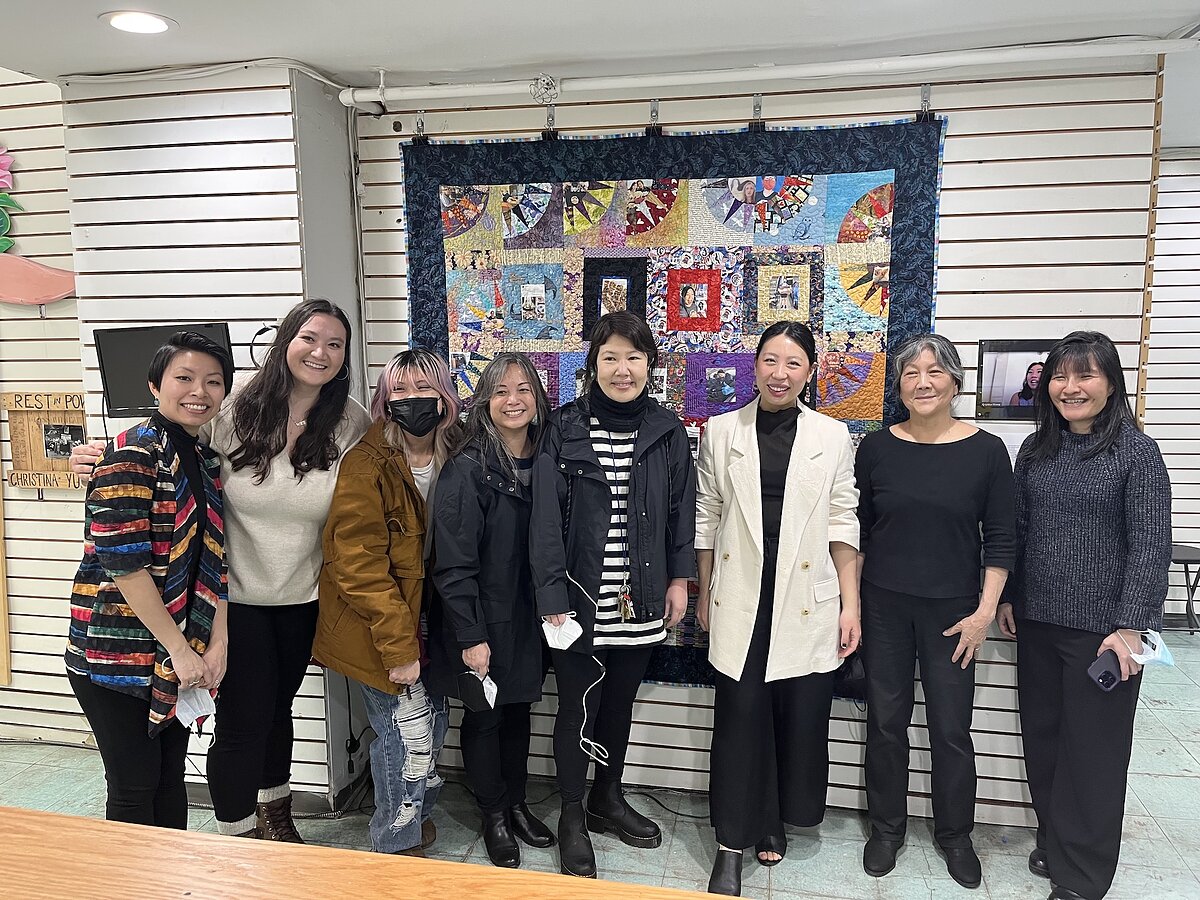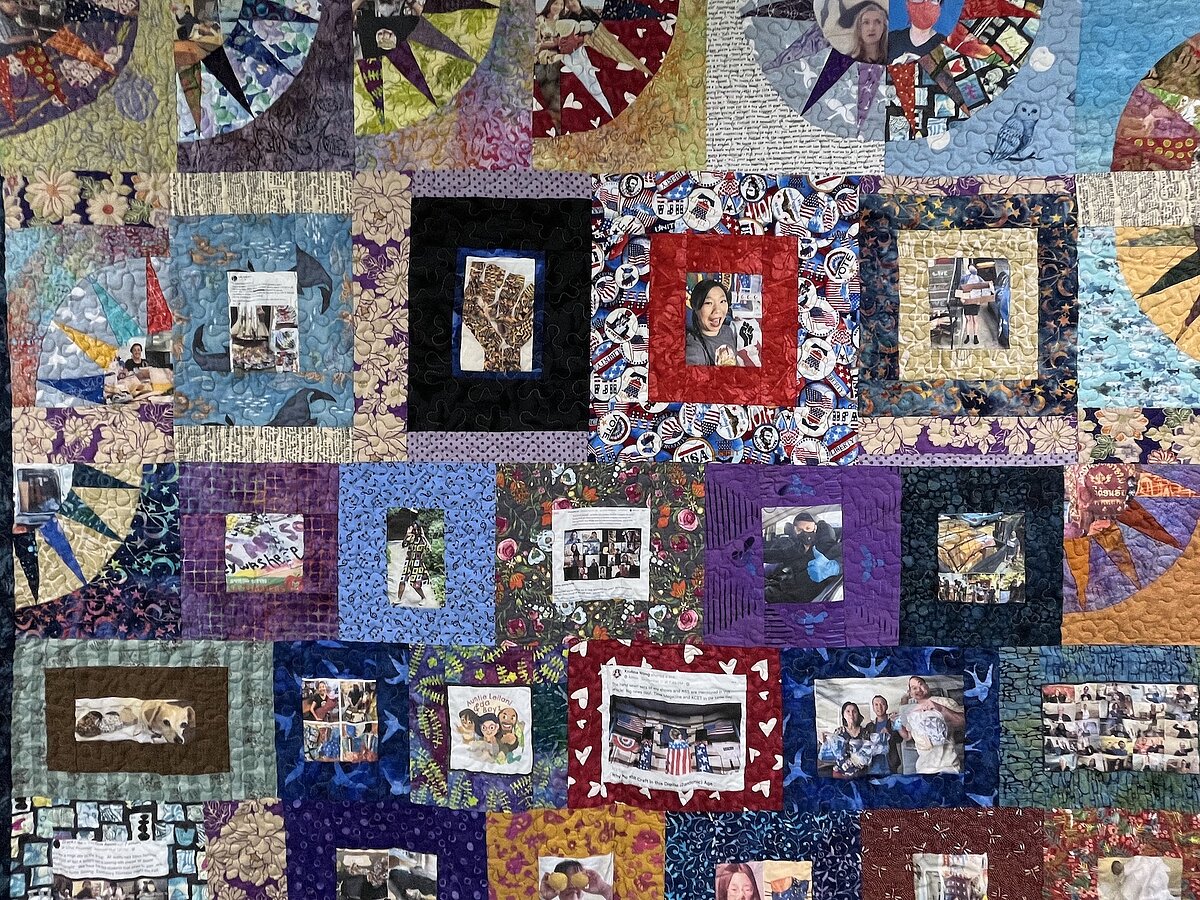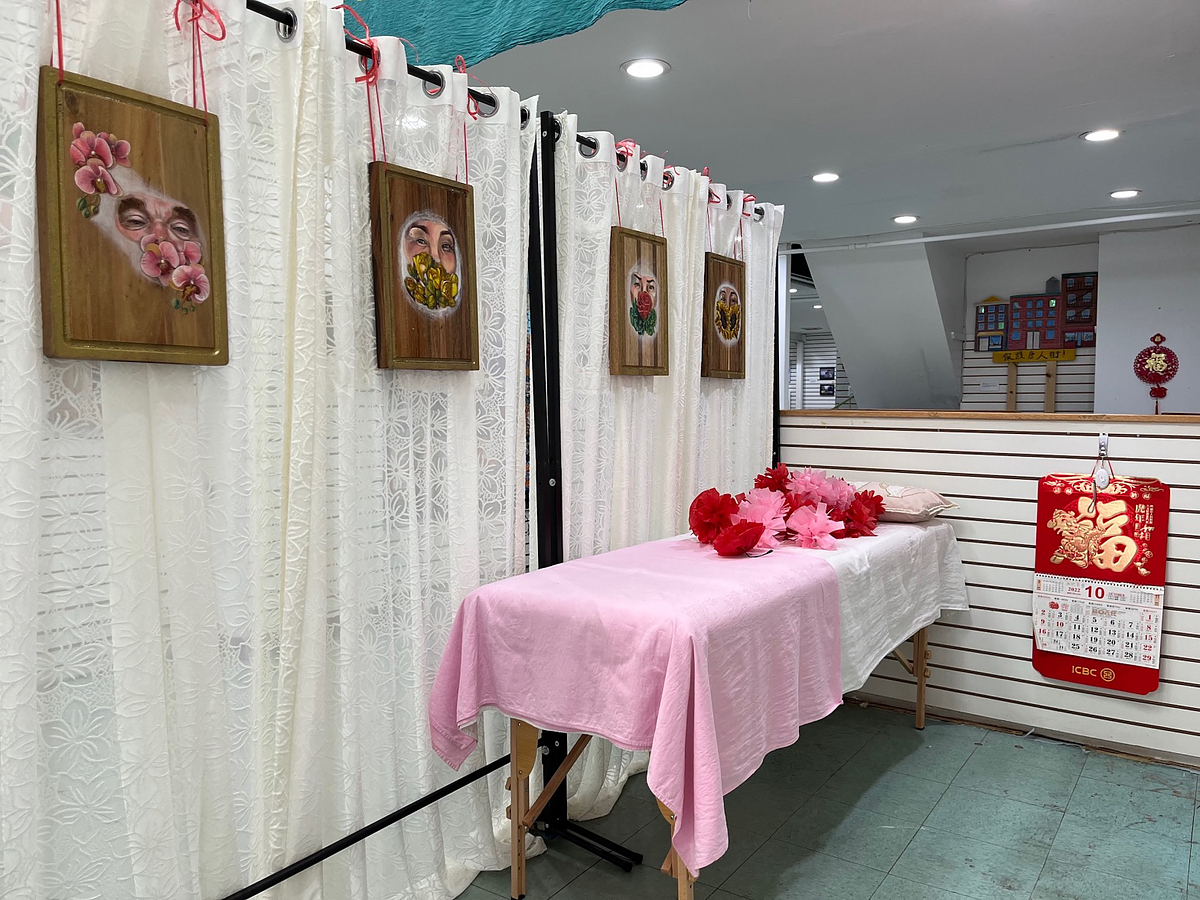Tomie Arai and Diane Wong on Collecting AAPI Stories
At 127 Walker St. in Manhattan’s Chinatown, a former empty storefront has been converted into a space for the community to heal from and reflect on the last three years since the pandemic began. Opening the same week as the Half Moon Bay and Monterey Park shootings, the exhibition transformed its front window into a living memorial. Stuck onto the glass are notes from visitors that give voice to our collective grief. “Thinking about the ways you might have lived and worked, helping to make sure your family was taken care of,” wrote one visitor. Another simply and unambiguously wrote and crossed out the word “guns.”
Titled, “Archive as Memorial,” the exhibition contains dozens of artifacts, video interviews, and stories collected as part of “A/P/A Voices: A COVID-19 Memorial Project.” Led by Tomie Arai, Lena Sze, Vivian Truong, Laura Chen-Schultz, and Diane Wong in collaboration with the A/P/A Institute at NYU, the project is the only major documentation effort focusing on the ways the pandemic has affected the Asian and Pacific Island community in America and will be housed within the university’s Tamiment Library.
Funded by the Asian Women’s Giving Circle, the exhibition in Chinatown allows visitors to see these materials in conversation with another: An installation by Red Canary Song paying homage to the victims of the Atlanta spa shooting and to immigrant massage workers is seen alongside a quilt crafted by the mutual aid group, Auntie Sewing Squad, painting a picture of community resilience and care through suffering.
“Archive as Memorial” is also the inaugural exhibition for Storefront for Ideas, an initiative created by Immigrant Social Services and Chung Pak, the owner of the building at 127 Walker, to repurpose empty storefronts in the neighborhood to amplify stories and local concerns.
The Amp’s Shannon Lee spoke with the exhibition’s lead curators, Tomie Arai and Diane Wong, to discuss the project, how community stories can serve as memorials, and how we might responsibly respond to tragedy.
Diane Wong: The project began a few weeks into pandemic lockdown in NYC when one of our close friends, Lena Sze, sent out an email about wanting to process what was unfolding around us—all of this death, grief, and uncertainty. A few of us responded to her initial email saying that we were interested in holding space for each other in a way that did not feel exhausting.
At the time, we were in a moment of the pandemic when we heard sirens every minute. The hospitals were out of space, and there were these temporary makeshift morgues across the city. We felt paralyzed by the world around us but also felt a sense of urgency to document how our communities were reckoning with so much loss that felt interminable. This project is an experimentation in mourning, both for our futures and our pasts.
Tomie Arai: That’s how I remember it as well. The team that eventually came together were friends and colleagues that worked on projects that overlapped in the past. We had all done oral histories together. I collaborated with Lena very closely on a project called “Archaeology of Change” at MoCA and I first met her when she was working on an oral history project at the Asian Arts Initiative in Philadelphia Chinatown. Embarking on a project that would collect interviews with Asian Pacific Americans during COVID-19 seemed like a good place to start.
As it turns out, we were only able to communicate remotely because of Covid protocols. For those of us who had conducted oral histories before, meeting in person and in spaces that felt comfortable and familiar were so necessary to the process of building trust between the interviewer and the narrator. But suddenly we didn’t have a choice.
We began by reaching out to people we believed were the most impacted by the pandemic. In the end, it wasn’t just an archive of the pandemic but an archive of all the different events of the last two years that had impacted our communities beyond the virus itself. There was the murder of George Floyd, the Black Lives Matter movement, the 2020 election, and the violence and scapegoating of Asians as a direct result of the policies of theTrump administration.
I remember watching the news nonstop during those two years and feeling helpless and isolated. Collecting these interviews and learning that people in the A/P/A community were actively responding to these issues, providing mutual aid and helping each other during this crisis was incredibly moving. Documenting the ways that our communities were supporting each other, lifting each other up, and making sure we got through this together gave this archival project purpose and meaning.
TA: We were all extremely aware that whenever some tragic event occurs, there’s always this need to document it. We wanted to avoid participating in an extractive process where we would ask people to share deep, personal emotions without giving them agency.
Creating this as a community archive was, by choice, a collaborative effort that was co-created. We’ve also been having a lot of conversations around access and how to honor the fact that these personal stories will live within a public collection.
DW: From being in academia and particularly through my training as a social scientist, archival work is too often seen as an isolating practice and as one of extraction. Many students still have this imagination of the archives as a dusty place where you have to wear these white cotton gloves and where everything you touch belongs to the past. But this project challenges all of that, we begin with the premise that archival work can be an embodied activist practice.
After we were awarded an Arts and Activism Grant from the Asian Women Giving Circle to support the exhibit, we had to secure a venue. We were approached by the Tamiment Library to showcase the collection on campus, and at the same time Immigrant Social Services in Manhattan Chinatown had reached out to Tomie about curating an exhibit at their Storefront for Ideas—a former empty storefront converted into a space for the community.
We decided to move forward with the exhibit at Storefront for Ideas, and became the inaugural Community-Amplifiers-in-Residence (CAiR) at Immigrant Social Services. As part of the exhibit, you can see, feel, listen to the materials in conversation with one another; the Auntie Sewing Squad mutual aid quilt next to Red Canary Song’s installation honoring the labor of sex workers next to Chinatown Tenants Union rent strike posters. For me, this was an important reminder that the archive takes on a new life when in community.
TA: As a visual artist, I’ve always been interested in the relationship between history, memory and art in public spaces. Our project and this exhibition allowed me to imagine the archives as a public space that could bring these different elements of change together.
The idea of collecting our shared experiences and reflections in the midst of a global crisis had such urgency. I think the exhibition came about because we felt the need to bring all of these digital recordings and images to life in some way. We thought the exhibition could be a space of gathering at a time when we were all so exhausted from the digital information overload and living remotely.
During the early stages of the A/P/A Voices project I was also a fellow with the Monument Lab, an organization based in Philadelphia that works with artists, organizations and movements to reimagine monuments and public memory. Over the pandemic, when people were tearing down Confederate statues, the Monument Lab was encouraging artists to create their own tributes to people who were murdered by police violence and question how we publicly acknowledge and memorialize the shared histories and the events that have shaped our lives.
The title of our project, “Archives as Memorial,” should be posed as a question: “Archives as Memorial?” Through this archive we were really trying to understand how to build memorials and public spaces to process our collective grief and loss. As a work in process we continue to ask ourselves how we can produce meaning together. These questions and the cohort we created over the past three years were critical to my own survival and sustained me through a very dark and chaotic time.
TA: When you talked about acts of love, it reminded me of our first public program which was called “On Community Care.” One of the things that came out of our earliest interviews was this need to find ways to heal and extend acts of kindness to people so they can feel supported and cared for.
Many of the early interviews we conducted in 2021 were very emotional. Not only were these conversations coming out of a space of deep trauma but it was also clear that these were feelings and community voices that hadn’t been heard before. As incidents of anti-Asian violence surge there are still currently no other major Covid-19 archives that I’m aware of that center the impact of the pandemic on A/P/A communities.
An ethics of care is something we recognized as central to our work. We were documenting stories in a moment of crisis and fear and efforts to provide care and mutual aid also extended to concerns for public safety. A lot of what we were hearing from our interviews was a turn towards abolition, defunding police and ending police violence.
Searching for alternatives to policing and mass incarceration really hit close to home here in Chinatown where we were fighting against the construction of a new jail. At 127 Walker we find ourselves directly across the street from the jail plan office and we share a wall with the jail they’re constructing. This is a chilling example of how we are directly impacted by these issues.
DW: Originally, we had thought of this exhibition as the project culmination but we ended up acquiring new materials for the archive and have identified additional narrators to interview. Among those already interviewed include mutual aid collectives, tenants fighting eviction, advocates for sex workers, street vendors, and nail salon workers, poets, artists, muralists, caregivers.
One of the interviews that resonated with me the most was conducted by Crystal Baik, with Kabzaug Vaj who is the co-executive director of Freedom Inc. They’re a Southeast Asian and Black-led organization based out of Madison, WI. The interview was conducted after the murder of George Floyd, Breonna Taylor, and Ahmaud Arbery, and much of the conversation was about the role of Asian Americans in abolition work.
Part of the interview that stuck with me was when Kabzaug talked about their “Police Free Schools” campaign to remove police from public schools led by their Freedom Youth Squad. Her narrative so beautifully signals how Asian American youth are at the forefront in the Black-led movement to reimagine safety and wellness in our communities.
Tomie and I placed Kagzuag’s interview and a photo of the Freedom Youth Squad on the wall in the gallery that is directly connected to the new jail that has broken ground in Chinatown, encouraging visitors to imagine a world beyond prisons and punishment.
TA: The interest from archivists, educators and community activists has been great. I think there’s an enormous excitement and curiosity about the project and the physical space itself.
As part of the Storefront for Ideas program, Diane and I are the very first Community Activators in Residence or CAiRS to occupy 127 Walker, which was once a souvenir shop that was rented by a merchant who was driven out of business during the pandemic. The building’s owners, the Chung Pak Senior Center, couldn’t rent the space because of the construction of the jail. Instead of renting it, they offered to gift the space to the Chinatown community for an unspecified period of time.
From the very beginning of the A/P/A Voices project, we asked ourselves how we could make the archives more accessible to the A/P/A community. Creating an exhibition from the archives and presenting it in a storefront space was a step towards providing more engagement with the archival process itself. Being in this space also feels like we are at the beginning of something that will be very good for Chinatown. Our project is just a small part of concerted efforts to build new cultural spaces –like the W.O.W Project and Think!Chinatown–that aren’t just white box galleries for contemporary art but are ways to bring artists and community together.
DW: The response has been overwhelming. Initially, I wasn’t sure if people would be ready to memorialize as we continue to live within the folds of the pandemic. But people have been so responsive. We’ve had hundreds of students visit the exhibit as part of their classes. We’ve had immense interest from residents in the neighborhood, some keep coming back. Cultural institutions across the country have reached out about contributing items from the archive to their collections.
What’s beautiful about memory work is that it can shape-shift with time. Archive as Memorial is one of the many lifeforms the A/P/A Voices Project has taken over the last three years—from a series of virtual programs to a public syllabus and improvised writing to annotated interviews and listening sessions to, most recently, a published article in the Journal of Asian American Studies.
Just as the archive keeps growing, the exhibit does the same. After the Monterey Park and Half Moon Bay shootings, we decided to put up a memorial on the storefront window where people could leave messages on sticky notes in remembrance. One visitor told me that she wasn’t sure that she even needed a physical space to mourn until she stepped into the gallery and wrote a note to post on the window. That action was cathartic for her, we need these spaces to gather our grief.





